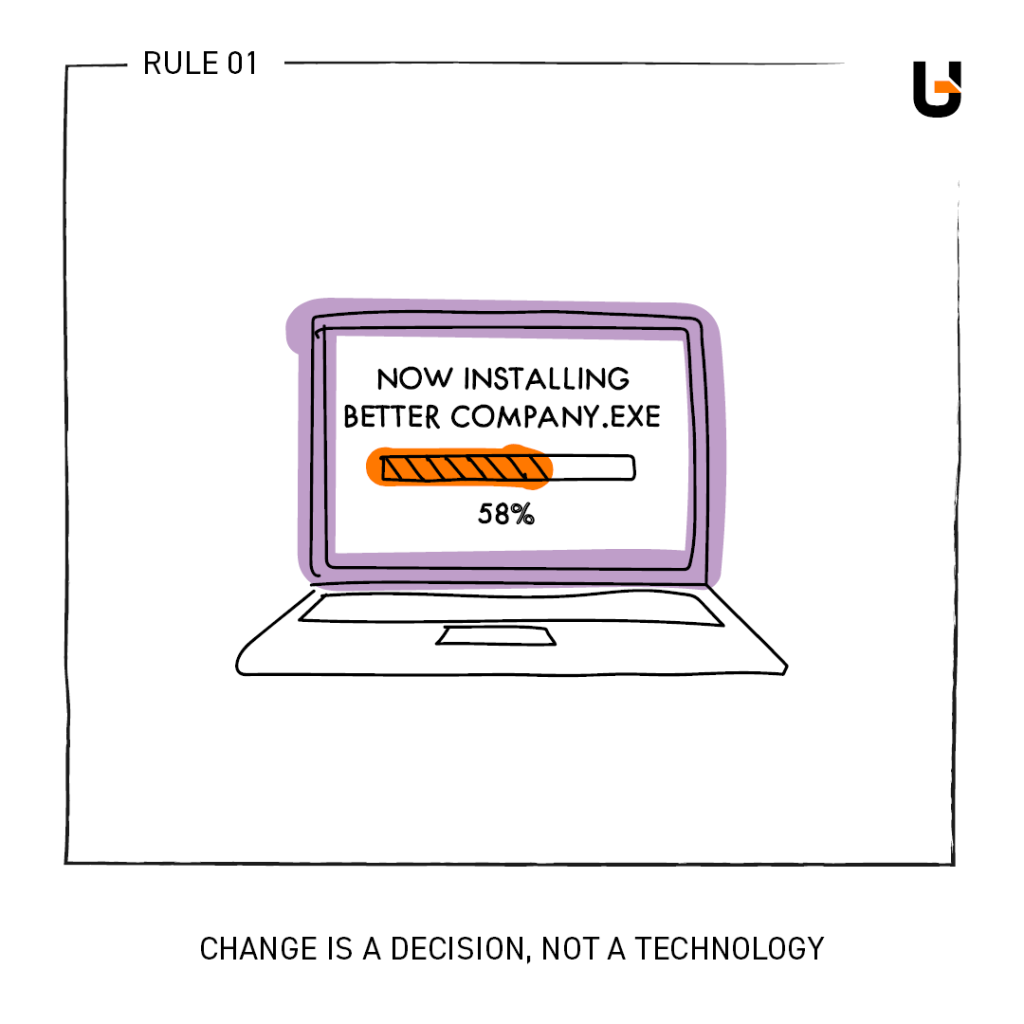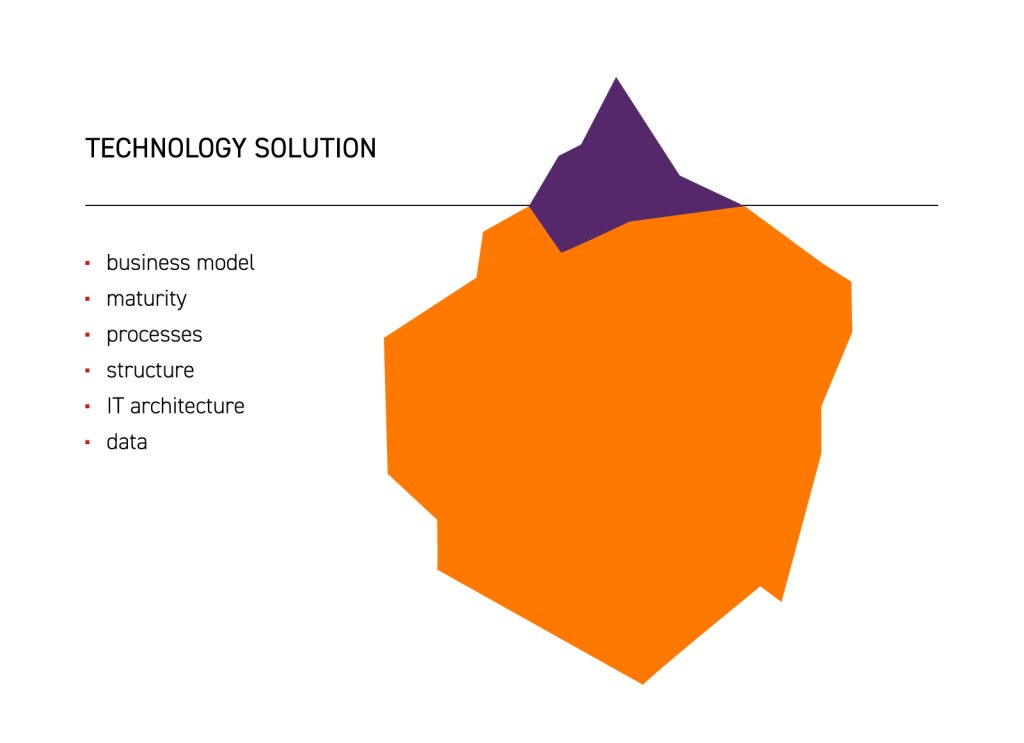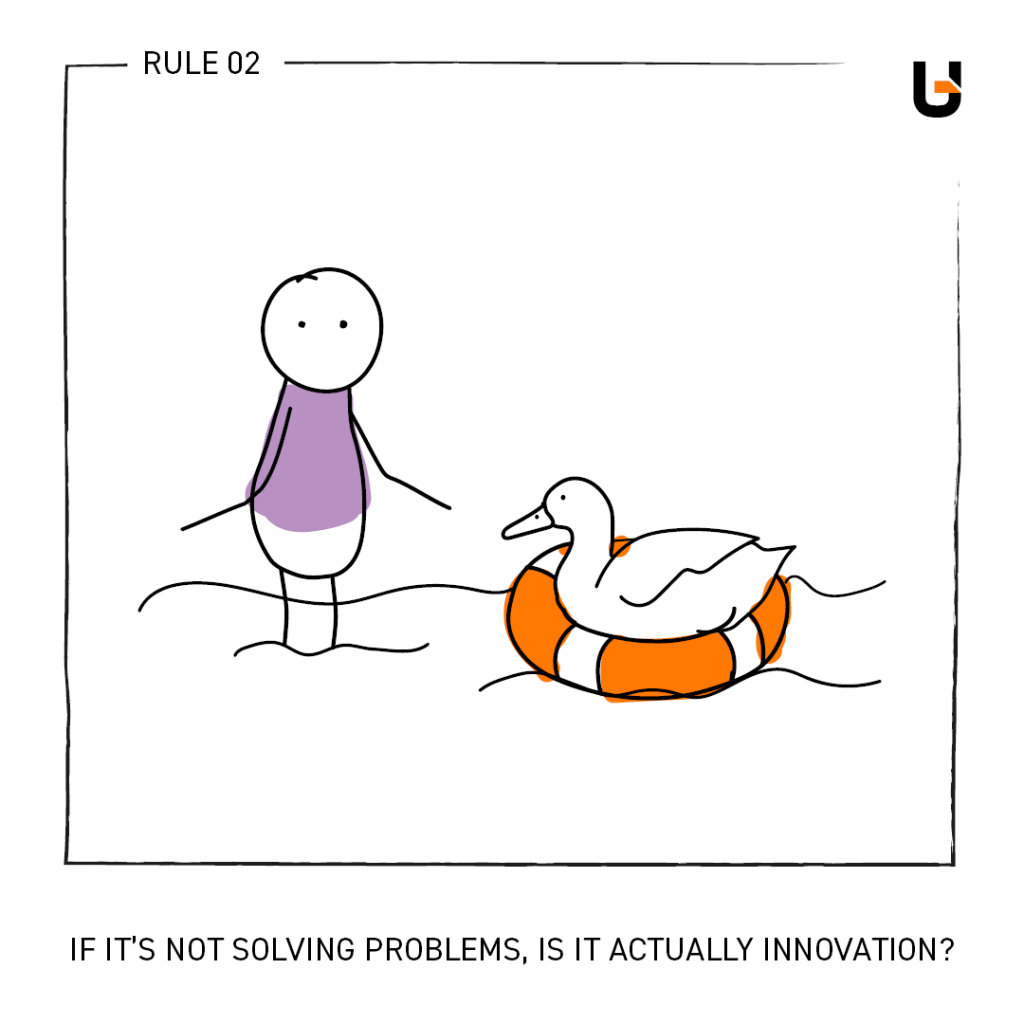Digital Transformation Pitfalls / Why Tech Isn’t Step 1
How do you climb a mountain? Do you find the highest peak and move forward, or do you assess the route and assemble the right crew and equipment for the task at hand?
Just like with digital transformation, there is a right answer here. More specifically, there are many questions that need to be answered first. Is this your first mountain? What is it you actually want to achieve? What do you different team members need to reach the top? And how far can we stretch this metaphor?
..and what happens if you skip these steps? In the quest for digital transformation, jumping into new technologies for immediate results is never a good idea.
Digital Transformation Definition
Digital transformation is the process of implementing of digital technologies within a business or organization. Subsequently, it is the removal of as many manual or analogue processes as possible, in order to optimize business efficiency.
So What’s the Catch? Digital Transformation vs Commerce Transformation
It’s better to reach the top safely, rather than quickly. In all the excitement of Digital Transformation, it’s easy to choose the shiniest technology on the market. But is the goal to simply be digital, or to make a noticeable improvement in the business?

There’s a reason we often refer to “commerce transformation” and it’s not just because we’ve got a stick up our backsides 😉 Since we arguably see many digital transformation projects as nothing more than technology for technology’s sake, we refer to commerce transformation as the careful selection and deployment of technologies focused around delivering a measurable improvement to a business’s success, whether that’s through saving costs, generating new sources of revenue or opening up entire new markets.
What Is the Purpose of Technology?
Returning to our mountain climbing analogue, technology can be compared to the right equipment in order to achieve your specific goal, whether that’s reaching the peak or a lower base camp. Without a clear goal in mind, technology doesn’t have a purpose.
Maybe you’re a transport company that wants to open reach an entirely new customer segment, expand your operational routes without computer latency, or even just clean up and save costs by updating the existing architecture.
Or maybe you’re in the construction and transportation industry and, through rapid growth and multiple sales channels, you need to automate processes while increasing the number of customers you serve.
In each of the above examples, the technology, while well-chosen, is only a means to achieving the predetermined goals. The digital solutions were only ever chosen once these are established.
The Updated Role of IT
We also need to recognize the shifting role of the IT department. In every company, the IT director is no longer responsible for keeping the base camp running. They’re now the captains leading the climb.
In other words, IT directors now find themselves aligning with business and sales goals, where previously their duties focused mostly on administration and smooth running of hardware. If the company wants more sales, expand into new markets or even merge with another company, the IT department is increasingly responsible for ensuring this happens successfully. In this new role for IT Directors, such individuals now need to choose technologies that can bring many benefits, but also great risks.
In fact, many of these digital transformation challenges are not only technical in nature, but also operational. After all, what good is a tool if people don’t know how to use it?
The Important Questions to Ask Yourself
As we said at the start, digital transformation is a strategic change, not just a technological one. So if asking “which technology” isn’t the right question… what is?
Doubling down on our mountain metaphor, it’s important to note that just as not every climber is immediately ready to tackle Kilimanjaro, not every business is ready for the most advanced or ambitious projects. Which leads us to a few hopefully now obvious questions…
How Mature is Your Company?
Digital maturity is the level of advancement a company has made in regards to digital technologies and their related processes. So, even if you know where you want to go, you first need to know where you’re currently at.
Ultimately, the right technology will be different for most companies. We can’t compare a company that has almost no digital tools to one that has already made some progress towards their digital strategy.
Maturity is a measuring stick for how well a company is doing. When checking across all corners of the organization, such as financial, operational, sales or customer service, you may find some are more advanced than others. We can further refine & discover this answer with the following questions.
What are Your Business Model?
One of the very first – and most important – things that you should do is a thorough analysis of the company’s business model(s), personas and customer journeys. Such an exercise enables you to look at the decision-making processes throughout, identifying their strengths, but also identifying any problems or barriers within how the company operates.
What are the Processes & Structures in the Company?
Alongside the larger business models, you need to consider the organizational structure and how processes are undertaken across it. Are there adequate competences in the team to manage new tools? How does the overall sales process look like? When do different departments cooperate or overlap in the process?
Asking these questions early on is extremely important for improving effectiveness. This will show not only where the most appropriate opportunities lie, but also where digital competencies need to be strengthened.
What Does the Current IT Architecture Look Like?
Once you’ve mapped the company’s business models and processes, it’s time to review the existing IT architecture supporting them. What systems are currently in place and how are they connected?
This is worth doing after the first two steps, as you should be looking at the architecture as a specific answer for the problems and solutions discovered previously. This way, you can determine if the existing architecture can support the business better with slight refinement or additions, or if ultimately requires major renovations. If the existing resources are still valid options, this will help avoid unnecessary expenses – and ensure greater business continuity during the process.
How is Company Data Managed?
Another vital area to consider before any technological change is the data management in place within your organization. Good data management is vital for making the most informed decisions, and getting the best results as a result.
It would not be good for different departments to be operating in more or less recent versions of data. Modern architecture should, where possible, remove silos and ensure the company acts on a single source of truth. Of course, with data management processes, we also need to pay due diligence to modern data laws, such as GDPR.
Getting the Full View
During this process, you will also see that digital transformation is not a mountain but something closer to an iceberg. In the focus on getting new digital changes implemented, we often overlook the organizational and internal challenges under the water.
After asking such questions, you now have a better understanding of your specific organizations, including its current pains, future goals and even industry-specific challenges. Armed with this, your every technology choice is better informed. After all, you’re no longer just “picking technology” but picking solutions.

What Happens if you Skip These Steps?
If you’re still not convinced, let’s think about the opposite approach. What can happen (and often does happen) when you start a digital transformation strategy unprepared?
Higher Costs… and Time
Jumping into a good solution now doesn’t mean it will be a good solution later. However, it’s often human nature to focus on immediate advantages over deferred benefits.
For example, point-to-point integration might seem ideal as early stages, where the structure is simple. Yet, if the company plans to develop further (and what company doesn’t plan to grow or expand?) this can become problematic. Changing to a more suitable infrastructure at a later data will only take even more time. And as they say, time is money 😉
Lack of Qualified Specialists
So you rushed in, developed the technology and all’s good right? Time to look under the surface again. We’ve seen some real world examples where PIM tools have been implemented, yet only 30% of the company’s products were supported. Without due training and preparation, employees stick to what they know, whether that’s local drives, paper copies or more. Oh, the horror stories we could tell you.
Inability to Read The Market
New technologies, frameworks and tools appear on the market on an almost daily basis. A quick glance at any technology radar will show you what we mean. There’s very rarely one clear and concise leader. Without knowing your own needs, how can you navigate such a broad array of options?
You End Up Outdated… Again
On a similar note, it’s important to understand that not every technology lives a full, happy life. As we’ve said before, every technology succeeds, right until it doesn’t. Knowing which solutions are gaining in support and are more likely to stay relevant is critical. But don’t fool yourself, few technologies last forever, so your goal is to maximize your value as much as possible.
In fact, for the most advanced companies, there are a range of infrastructure and IT solutions, such as composable and MACH architecture, that actively try to solve this once and for all. They focus on individual microservices rather than big, clunky platforms. That said, this requires understanding the wider services available so, as we said, not every technology fits the right company. You have to know your maturity first!

When Technology Is Top, Start From the Bottom
Whether it’s a mountain or an iceberg* we hope we’ve shown you that technology is the very end point. Instead, you should place your focus on the company’s strategy, processes, available resources and current IT architecture in order to plot the best source.
Naturally, this does require some effort and dedication of time. Nobody said it would be easy 😉 Throughout this process, you must also remain objective and impartial. You may have to speak some hard truths, or make people aware of pitfalls they weren’t aware of. You may also need to bring in some objective, external help to ensure this end result.
The hours spent on such analyses, finding weaknesses and researching the right solutions, may seem like a lot at the start, but it all helps you prepare for a happy, less stressful approach to the summit. And the view is always better once you get to the top!
*You’ll be happy to know our marketing department has used their metaphor budget for the month.








